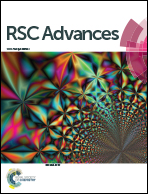Research progress in the development of organic small molecule fluorescent probes for detecting H2O2
Abstract
Hydrogen peroxide (H2O2), as an important signaling molecule during biological metabolism, is a key member of the reactive oxygen species (ROS) family. The excess of H2O2 will lead to oxidative stress, which is a crucial factor in the production of various ROS-related diseases. In order to study the diverse biological roles of H2O2 in cells and animal tissues, many methods have been developed to detect H2O2. Recently, fluorescence imaging has attracted more and more attention because of its high sensitivity, simple operation, experimental feasibility, and real-time online monitoring. Based on the response group, this study will review the research progress on hydrogen peroxide and summarizes the mechanisms, actualities and prospects of fluorescent probes for H2O2.



 Please wait while we load your content...
Please wait while we load your content...